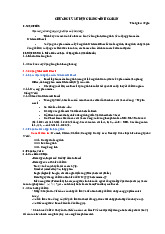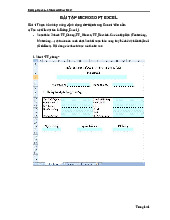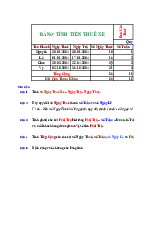





Preview text:
NameClass Date
Open-Ended Inquiry
Chapter 9 Lab
Plant Pigments and Photosynthesis Ask Questions
Which wavelengths of light support plant growth? Introduction
The process of photosynthesis involves a complex series of chemical reactions that involve
multiple plant pigments, such as chlorophyll, as well as a variety of enzymes and intermediates.
With this process, plants convert energy from the sun into energy that is stored in food. The
chemical equation shown below describes the overall process.
6CO2 + 6H2O -> C6H12O6 + 6O2
Much of the light energy from the sun is transformed into the high-energy chemical bonds of
glucose (C6H12O6). However, sunlight is not one single type of light, but instead is a mixture of
light of various wavelengths. Each wavelength of light appears as a different color. From lowest
to highest wavelengths, the colors of light include red, orange, yellow, green, blue, indigo, and
violet. (Remember the acronym ROY G. BIV.) You can reveal these colors by passing sunlight
through a glass prism, which generates a rainbow effect.
The various plant pigments specialize in absorbing light of different wavelengths. The line graph
below plots light absorption against wavelength for two pigments: chlorophyll a and chlorophyll b. NameClass Date
In this lab, you will investigate the wavelengths of light that are used in photosynthesis, and
construct an explanation for how light wavelength affects plant growth. You will use Elodea, a
type of aquatic vegetation, as a test subject.
Focus on Science Practices
Plan and Carry Out an Investigation, Collect Data, Analyze and Interpret Data
Materials per group
• 500-mL beaker or similar container • 3 rubber bands • test tube
• grow light or sunny window
• sprigs of Elodea or other aquatic plant • colored cellophane paper • funnel (clear plastic) • tape • 1 g sodium bicarbonate • scissors • distilled or spring water • stirring rod Safety
Wear safety goggles and plastic gloves during this investigation. If you are using glass test
tubes or beakers, check for cracks or chips. Alert your teacher if you break a glass object. Be
careful when using scissors. To avoid electrical shocks, make sure that cords, plugs, and your
hands are dry if using the grow light. Remember never to eat or drink in the science lab. At the
end of the procedure, wash your hands thoroughly with soap and warm water.
Plant Safety Handle plants only as directed by your teacher. If you are allergic to certain plants,
tell your teacher; do not do an activity involving those plants. Avoid touching harmful plants such
as poison ivy. Wash your hands when you are finished with the activity. Procedure
Part A: Investigate Photosynthesis
1. Fill the beaker about 3/4 full with distilled or spring water.
2. Add 1 g of sodium bicarbonate (NaHCO3) into the beaker. Use the stirring rod to mix the
sodium bicarbonate thoroughly into the water.
3. Place two or three sprigs of Elodea into the mouth of the funnel. If the sprigs are too large,
cut them to fit. The sprigs should fit snugly.
4. Hold the Elodea sprigs in place as you tip the funnel upside down, and then submerge it into
the beaker. The sprigs should be trapped inside the funnel. Hold the funnel down to prevent
it from floating to the top of the beaker.
5. Observe whether the inverted funnel is completely submerged in water. If necessary, add
enough water to cover the stem by at least 2 centimeters.
6. Submerge the test tube in water to completely fill it with water. Or, fill it by pouring water into
the test tube, place a finger over the open end of the tube to hold water inside, and bring it to your beaker. NameClass Date
7. While keeping the test tube underwater, turn it so the open end points down. If you observe
air bubbles inside the test tube, repeat step 6 and this step until no air appears.
8. Place the test tube over the stem of the funnel, making sure that no air bubbles get inside.
Use rubber bands to hold the test tube in place.
9. Place the apparatus near a grow light or sunny window. Observe any changes on or around
the Elodea sprigs. Record your observations. 10.
How could the apparatus be used to analyze the rate of photosynthesis in Elodea? (Hint:
Review the overall chemical equation to identify the reactants and products.)
Part B: Investigate the Effect of Light Wavelength on Photosynthesis
11. How will colored light affect photosynthesis in Elodea? Which colors of light do you predict
will support the greatest rate of photosynthesis? Which colors will support the lowest rate?
State your prediction in the form of a hypothesis. NameClass Date
12. Discuss your hypothesis with the class. Then, working together as a class, plan an
experiment for the class to conduct to test one or more related hypotheses. All groups may
use the apparatus from Part A, as well as other materials available to you. Record the steps of the procedure.
13. With your teacher’s approval, follow the steps of your procedure and conduct the
experiment. Create a data table to record the results. NameClass Date
Analyze and Interpret Data
1. Develop Models Create a sketch or diagram to serve as a model of photosynthesis. The
model should show how photosynthesis transforms energy and matter. Begin by drawing an
Elodea sprig. Then add labels and arrows to show the reactants, products, and energy source for photosynthesis.
2. Use Models For the Elodea sprigs in Part A, what was the source of each reactant of
photosynthesis? (Hint: Review the model you created for question 1, as well as the diagram
shown in Part A of the Procedure.)
3. Construct an Explanation Identify the products of photosynthesis. In Part B, how was one
of the products useful for comparing the rate of photosynthesis among different test groups?
4. Draw Conclusions Did the results of Part B provide evidence in support of the hypothesis
or against it? Or were the results inconclusive? Explain. NameClass Date
5. Defend Your Claim Make a claim about the relationship between the growth of a plant and
its rate of photosynthesis. Then defend your claim by applying scientific reasoning and your knowledge of photosynthesis.
6. Develop Possible Solutions At many greenhouses, plants are raised under artificial light
sources, such as electric lamps. Could the results of this investigation help greenhouses
lower their electricity costs? Explain your reasoning.
Extend Your Inquiry
Design an experiment to test another variable that could affect photosynthesis and plant growth.
Examples of these variables include air temperature, light intensity, and periods of light and darkness.




